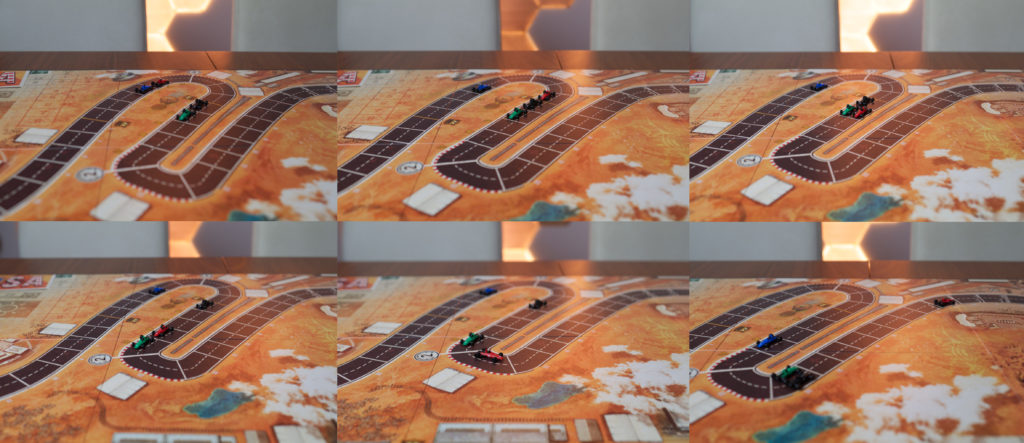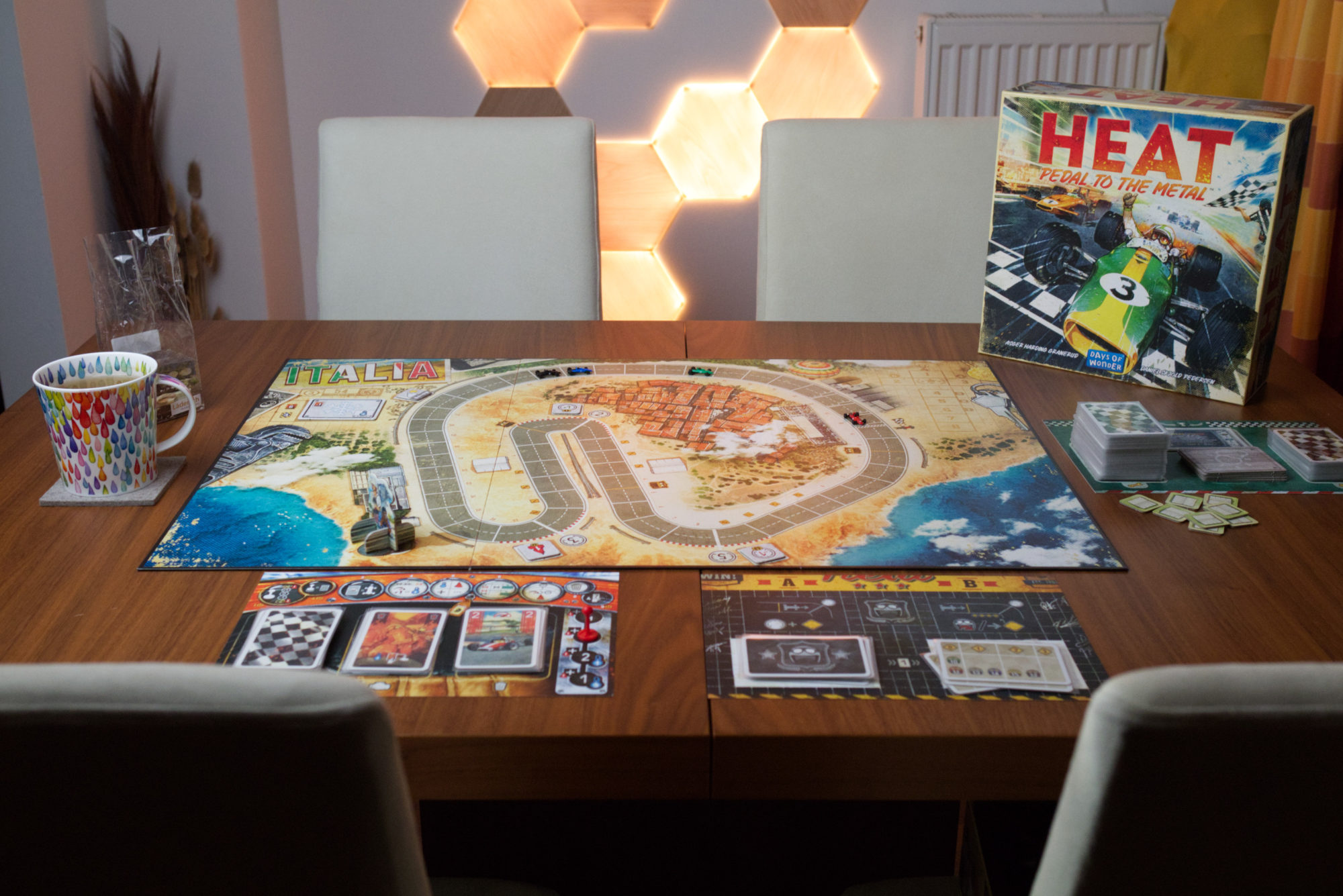We’re approaching the next corner and I’m way too fast. In the front, the leader is trying to pull away from me so I have to keep up. In the back, the rest of the competition is breathing down my neck. There is a discerning amount of stress, heat is starting to build up, and the numbers I’m looking at are not what I had hoped for. I’m kind of anxious but there is a huge smile forming on my face … that was turn three of my very first game and when I realised I was already digging this game!
It’s rare that I play a game and am really blown away right from the start. Dune Imperium comes to mind, or more recently Carnegie. But this gotta be a record and I am not even particularly into racing games. Sure, I used part of my very first proper paycheck to buy a second hand copy of the long out of print, original version of Robo Rally with the nice metal robots. That was primarily due to sentimental reasons though, having played it tons with friends at school. Robo Rally is a tremendously fun but ultimately flawed game. I’ve never really liked Formula Dé, Um Reifenbreite wasn’t my cup either. No racing game comes to mind that I really enjoyed enough to even consider a purchase. That is until Flamme Rouge came around. It had a great variable track system, the theme was endearing and it managed to convey the constant struggle to preserve power that is essential to any bike race. It wasn’t just “get there the fastest”, it was a case of “you might not get there at all”. The Peloton expansion added among other things a couple of different track elements as well as automa and the Meteo expansion even added weather effects. But for some reason, it never hit the table as much as I had hoped it would. I had big hopes for the Grand Tour expansion to at least give me a reason to play it solo more, but that has been on the horizon for a long, long time, always out of reach.
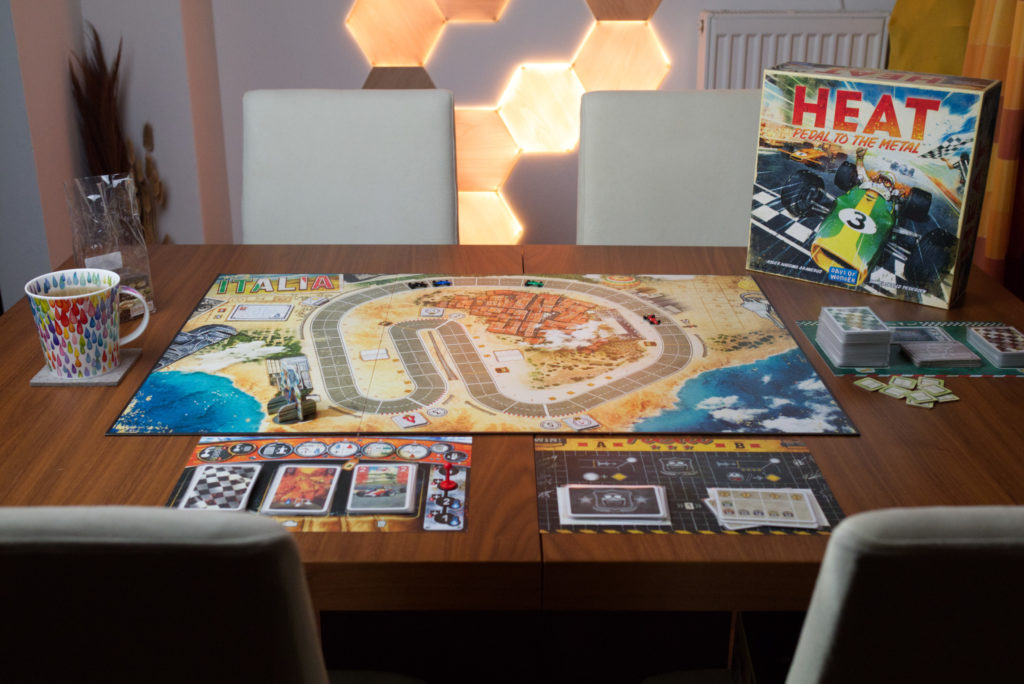
In swoops Heat: Pedal to the Metal, also by Asger Granerud, now teamed up with Daniel Peterson and Days of Wonder. I wasn’t sure if I would like it or even needed it in my collection with the full set of Flamme Rouge already being part of it. But let me put it this way: I don’t think I’ll be playing Flamme Rouge again any time soon…
Setup
It’s surprisingly quick to set this game up, a fact that is helped by the excellent inlay that comes in the box. Pick one of the four maps, give each player a player board (thick paper instead of the usual cardboard), their car, a gear lever and their starting deck. Pick an optional number of non-player opponents to take part in the race, randomise the starting positions and off you go.
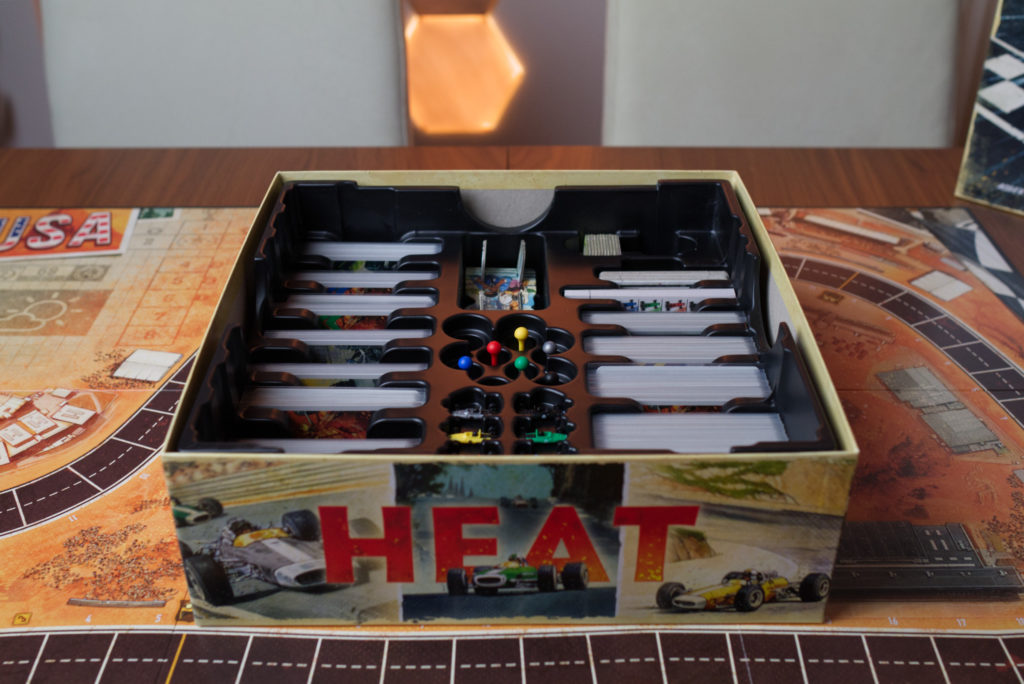
A player’s initial deck consists of the card values one to four (three each) and three upgrade cards: a zero, a five and a heat. Heat – in an abstract way – represents elements of non-permanent exhaustion of your car like the breaks losing efficiency or tires getting too hot. Mechanically, it clogs up your hand because it can neither be played nor discarded. The only way to get rid off it is to slow down and let your machine cool. In addition, each player shuffles in three stress cards that add a level of uncertainty to the decision process and puts a reserve of six heat cards on a separate area in the middle of the player board. Think of this pile as the safety margins or amount of structural integrity that can still withstand further increases of heat in your car. You want this pile to be as big as possible. Any heat that leaves it and enters your system is a looming problem that will certainly hit you later on.
The Turn
A race typically consists of two rounds around the chosen track. Each turn begins by all players simultaneously picking which gear they want to drive in that round, equating to the number of cards they’ll be playing. A single gear up or down is free, doing two steps up or down causes a penalty of having to move one heat from the personal supply to your personal discard pile. Got no available heat? Well, no quick shifting for you. While bigger gears allow you to do bigger movements, they can run you into problems in the corners. Smaller gears cap the amount of movement you can do but also allow you to put heat from your hand back to the personal supply, thus removing it from the system.
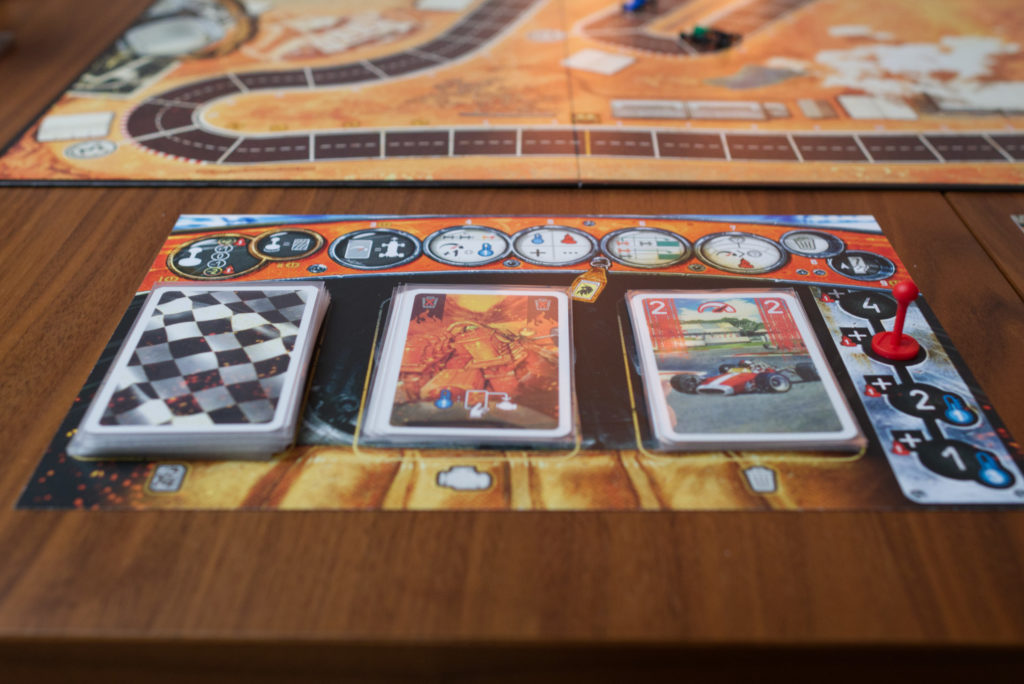
Next, all players put out the cards (face down) they want to play that round and then one player after the other performs the rest of their individual turn. The first step is of course to reveal the cards chosen. Most cards show a number that simply adds up to the fields the car will move this round. Stress cards instead show a plus sign which means the player has to reveal cards from the top of the draw pile until a movement card comes up and its value is added to the total movement. Any heat or stress cards thus revealed are simply skipped and put onto the discard pile.
The player’s car then moves that many spaces plus an additional space if the player is currently in last place, a mechanism that reminded me of the famous rubber banding in Mario Kart. It helps to keep everyone engaged in the race, even if a player has a catastrophic problem mid-race.
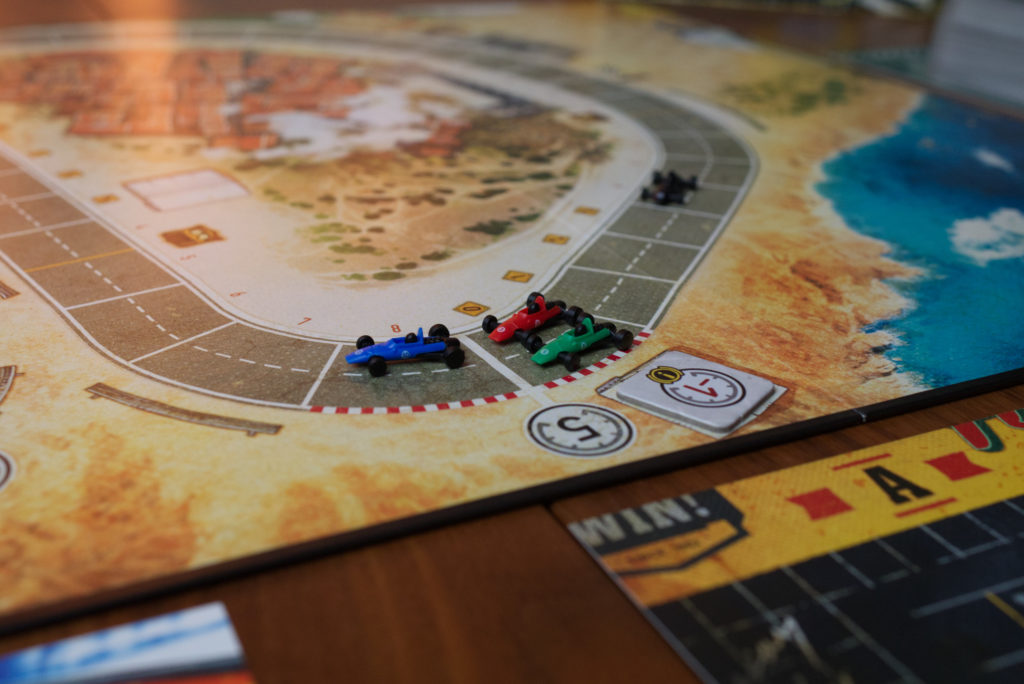
An element taken over from Flamme Rouge is slipstreaming, although it works completely different here. Instead of having to create a small gap between you and the cyclist in front of you, here you need to end your movement either directly behind or next to another car to trigger slipstreaming which will propel you forward exactly two additional spaces. This might seem a rather big and thus easy margin to hit but keep in mind that cars often travel 12+ spaces in one turn. So while difficult on long straights, you have a good chance using it in tight corners where the end placement of other cars is more predictable due to the slower speeds.
I’ve skipped over a few details but the biggest one is the ability to boost. After movement before slipstreaming, a player can spent a heat (move it from the supply to the discard pile) to reveal another movement card from the deck and add it to the total movement. This makes it even more likely to achieve slipstream, but the cost can prove to be too high in the long run. More on that later.
If the player traversed a corner, they have to now check their speed (as in sum of points, slipstreaming is excluded) and compare it against the value printed on the corner. For any excess speed above the corner value, one heat needs to be spent. Don’t have enough heat available? Your car spins out (stops in front of the corner) and you get additional stress into your hand. This is probably the last thing you want happening to you. Not only is there no way to ever remove stress from the deck, making further turns less predictable. It can also throw you back so far that you need to pray that a similar fate will strike your opponents as well. But due to rubber banding and a sizeable amount of tight corners, there is always hope to catch up…
Finally, the player then is allowed to discard cards (except for stress and heat which one can never discard) and then fill up the hand back to seven cards. Discarding is surprisingly powerful, allowing you to churn through your deck in search of the right movement values. It however, also runs you the risk of accumulating more and more heat/stress faster. The inverse is also very powerful. Powering through long straights can be a great time to collect low value cards like zero or one, allowing you to move through tight corners while still in high gear.
End of Game
A race typically ends after just two rounds around the track and since each individual turn is over rather quickly, the game proceeds at a fast pace. This is the kind of game where you just made up your mind on how to deal with the problems of the current round and a few seconds later are already fretting about the next round. I was reminded of Concordia in that each turn feels like a micro-turn that barely slows down the overall progress of the race. Especially playing solo, it feels like chose-move-automa-done, chose-move-automa-done, chose-move-… it has a rhythm to it that makes it feel like I’m part of a realtime race.
The game is over once a car crosses the finish line. However, the the rest of the players still complete their turn and then the car that traveled the furthest behind the finish line wins. This produced neck-to-neck photo finishes in multiple of my games.
Solo Mode
The game comes with cars and cards for up to six players, any of which can be replaced with a bot. What makes this really low overhead even for multiple bots is that they are all moved using a single card. When the first bot in a round needs to move, the top card of the automa deck is revealed and that states the movement for all six colours. There are two values associated with each colour: a movement value printed on its helmet and the corner value.
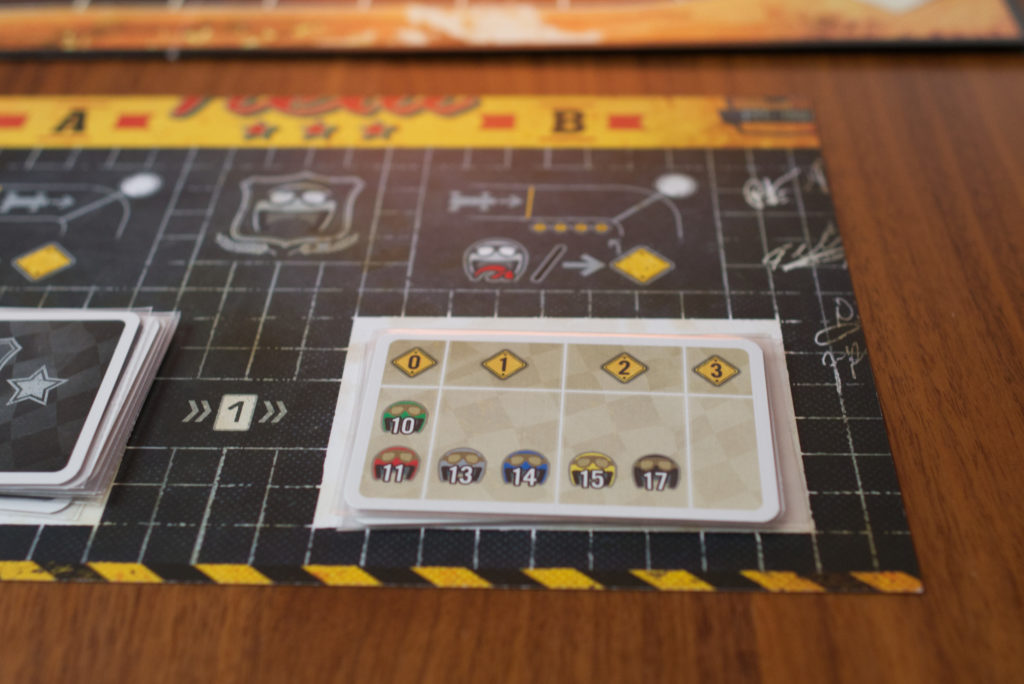
The automa uses a different behaviour depending on whether it approaches a corner or is already in it, as indicated by an orange line on the track. If it still is in front of the line, the car will drive the full movement value shown on the helmet unless it would cross the corner line. If so, instead place it on the field indicated in the top row (0-3 spaces in front of the corner). When a bot is beyond the orange line but in front of the corner line, it will instead travel equal to the corner value plus the value in the top row.
Together this produces some astonishing back and forth between the cars. Once out of a corner, the cars will shoot away like the tiny rockets they are, only to slow down just before the middle of the corner, then accelerate coming through the corner and away out of it. As the human player, you need to spent heat and go over the curve limit to catch up or – if you are lucky – even overtake in the corners, but that adds heat to your deck and gives the bots a chance to catch you on the straights.
The rules recommend adding at least two bots when playing solo but one can easily play with a full complement of cars, it’s that quick to administrate. If things get too easy, the rules suggest adding additional movement points to the values shown on the card. It took me 2-3 plays to really understand the mechanisms of the game and I now have a healthy win-ratio playing against 3 bots. However, it is still tense and I have the feeling I earned it if I manage to win. After 10 plays or so, I now slowly get to the territory where I might experiment with increasing the difficulty.
A single race takes about 30-45 minutes and a championship of 3 races can be done in under an hour.
Extra Content
What is surprising about Heat: Pedal to the Metal is what is in the box and what isn’t. The inlay has slots for 8 cars, 8 gear lever and 8 player card sets, but there are only 6 in the box. This seems odd at first, but I believe Days of Wonder made the right move here to keep the price down. 6 cars is more than enough to have lots of fun on the rather short tracks and for those that really love the game, I’m sure it is only a question of 6-12 months before the first expansion will add the other colours. But the game feels great as is, let me stress that.
On the flip side, there is so much additional content in the box that it feels like someone put all expansions plus parts of the upcoming Grand Tour into the base box of Flamme Rouge! To start with, there are four (!) tracks included in the box, my favourite being Italy with it’s long “straight” and really tight corners.
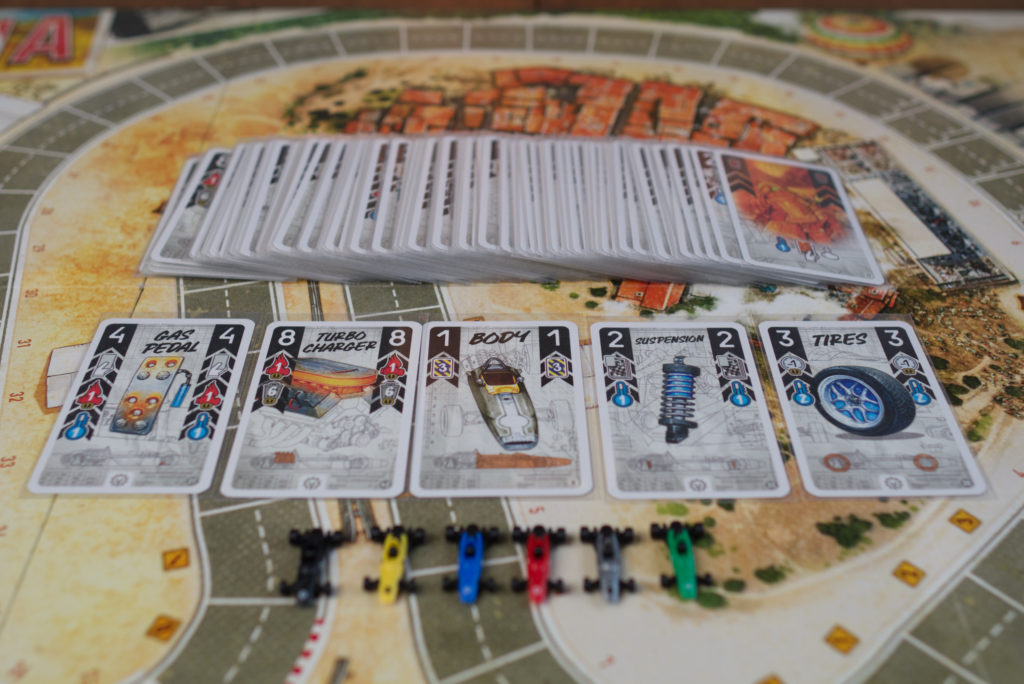
There are upgrade cards that replace the original 0/5/heat in the starting decks and are drafted at the beginning of the game. While the combination of name and function is sometimes odd (why does a four wheel drive have the same effect as three stress cards? Fells more like a Nitro boost), I simply love them. Each upgrade adds personality to your car and since the optional discarding at the end of a turn helps churning through the deck, you’ll see them multiple times during a race. My favourite so far are the Tires that allow you to increase the value of a corner by one, but an additional cooling system to get rid off heat also is really helpful.
Then there is weather and track conditions, changing the values of corners, allowing for additional cooling or adding initial heat/stress to your deck from the start of the race. The thematic integration is great here. For example, starting in heavy rain adds stress to the player decks.
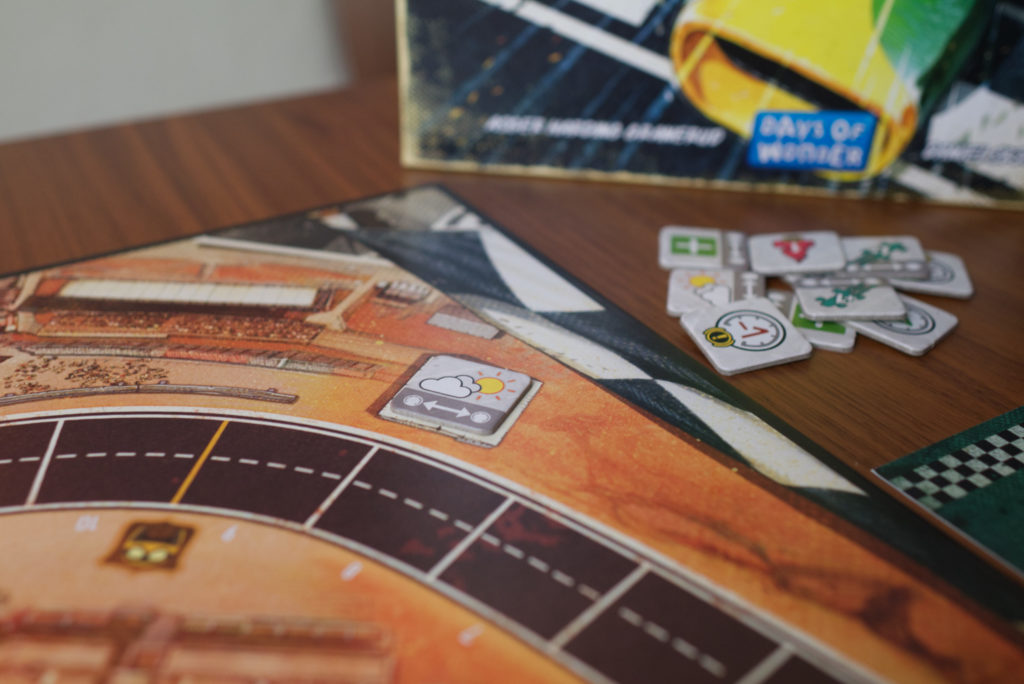
Then there are the bots (called “Legends”) themselves which just take one page of rules and as described above work really well.
And if that all wasn’t enough, there is a championship module with sponsorship cards (one time use effects), press corner (tempting the players to do risky manoeuvre in a particular corner) and events that modify each in a series of races (e.g. 2 more championship points for a particular race). There are three championships included which are 3-4 races long but the rules offer suggestions on how to make up custom championships using the same event cards. I hope Days of Wonder takes a page out of Troyes Dice’s playbook. The Troyes authors have over the months published multiple scenarios/variations to base Troyes Dice that kept the game fresh long past its due date. Would be awesome if Days of Wonder had a monthly special race or something on their website. If not, I’m sure the BGG community will do it 😀
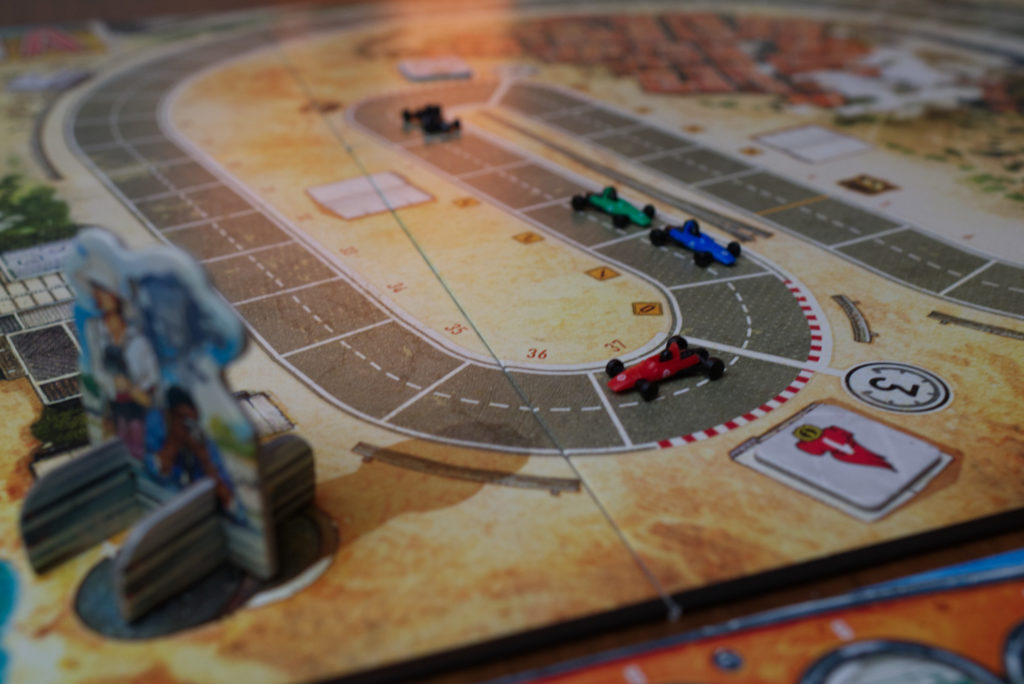
Conclusion
While I like Flamme Rouge a lot, Heat: Pedal to the Metal is the game I had been looking for without realising it. If I’d have made a wish list for Flamme Rouge Grand Tour, Heat: Pedal to the Metal would have nailed pretty much every point on it. Plays great solo, warrants lots of repeated plays, exciting to a point that gets the blood pumping, a “campaign” mode that gives me reason to bring it to the table more often, super fast setup, lots of variability and character. When the box arrived, I opened it with a nervousness if this could really add anything to Flamme Rouge or would be just the mass market dumbed down version of it. As written in the beginning, it took just three turns and I was completely hooked. This might very well be the most fun solo experience I’ve had all year.
What’s astonishing is how much the authors have managed to distill the essence of a car race with its back and forth. The fact that this is a complete package (despite the two missing player colours) from the get go also scores highly in my book. Someone can buy this box and is good for months. I remember a time when Days of Wonder was the pinnacle of game production with lush graphics, great game play and an overall luxury experience. Of course times have changed with the advent of Kickstarter and publishing houses like Eagle Griffon Games. Still, Heat: Pedal to the Metal feels like Days of Wonder is finally back to form. I’m sure they will issue a Ticket-to-Ride-sized amount of additional maps and content over time, but I would say rightly so. The core game system works that well and I’ll be first in line to get new content… which I realise is ridiculous as I just stressed how complete the package is. I can only liken it to Concordia or Dune Imperium: the base game is already awesome and if I couldn’t play anything except it, I would be a happy man. It’s still fun though to explorer new things when/if they might come around.
As enthusiastic as I am for Heat: Pedal to the Metal, it must be said this will not be so for everyone. Flamme Rouge for example feels more deterministic and strategic where Heat feels more like an arcade game: everything is optimised for fun. Players are not as much in control as in some other racing games, and it is precisely that mix of moment-to-moment tactics and dealing with uncertainty that makes it fun for me. There is however a lot of skill to the game, my results now are way more consistent than my initial plays.
I also want to stress the many usability optimisations that have clearly been added here. For example, there are small numbers next to each space of the track that show the distance to the next corner. This speeds up all the calculation one has to do a lot and makes updating the bots that much faster. There is the inlay to keep everything sorted and make setup quick. I’m even happy that the variable track piece design of Flamme Rouge has been replaced by static maps, something that I would never had guessed if you would have asked me before playing Heat. The savings in setup time more than make up for the lost flexibility in my book.
There are few things to complain about here. The art is nice, rules are good, tracks feel fun. The inlay even works for sleeved cards! The cars are a bit smaller than I had thought but they work and after a flood of way too large main boards lately (Sabika, Castles of Mad King Ludwig CE, Lacrimosa, …), the maps of Heat actually feel well sized. I can get it and six players on my moderately sized table, no problem.
My wish list to Days of Wonder would mostly consist of an optional add on for nice metal cars and gear levers. Especially the levers are just too light and topple over from time to time. I don’t really mind the thick paper instead of cardboard player boards. The thing that caused me the biggest problems is that there is no round tracker. I had two plays where I was so much into the moment that I wasn’t sure if it was the end of the first round around the track or already the end of the race. Seems like a strange oversight…
Gamewise, I think Heat is brilliant in its simplicity and emergent gameplay. The rules take a bit getting used to and you should regard the first 2-3 plays as practice rounds. The bots do a great job here as a pace maker that shows what is possible, though their corner movement is easy to mess up when playing solo. Took me 3 plays and now it’s smooth as butter.
The only thing I find slightly odd is the way stress works. There is no penalty for revealing heat cards and thus as a side effect stress can be a great way of getting heat from your deck to your discard pile without clogging up your hand. The rules also say that one is not allowed to check the discard pile and for good reason. If you count cards (as in memorise already played values), stress becomes rather predictable and that can be a serious edge over other players. So as a house rule, I would add players are not allowed to count cards.
To sum it up, a fun game and great package all around. Unfortunately, it’s hard to convey the excitement of playing Heat: Pedal to the Metal. So let me close these first impressions up with a big thumbs up from my side and an example from one of my races: It was the final round of the USA race and the field was approaching the final two corners. I (red) was in third place and knew I had to spend the last of my heat reserve to somehow get to the front before the straight came up. I took a guess where the first (green) and second (blue) car might end up, powered through the first curve to end up right behind blue, allowing me to slipstream next to the front of the pack. Since the next corner was even tighter, I hoped the leader (green) would break too soon and chose my cards so I would end up right behind him, which worked and the slipstream propelled me around the corner without costing me any heat (of which I had none remaining). I was the only car past the speed limit, able to shift up and shoot away next turn, off to a glorious victory…
